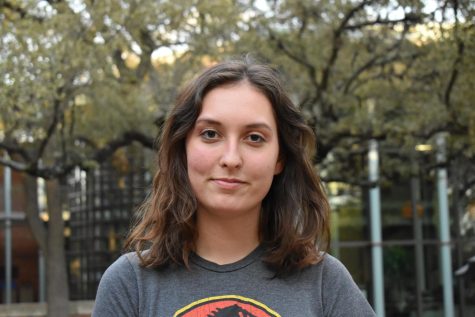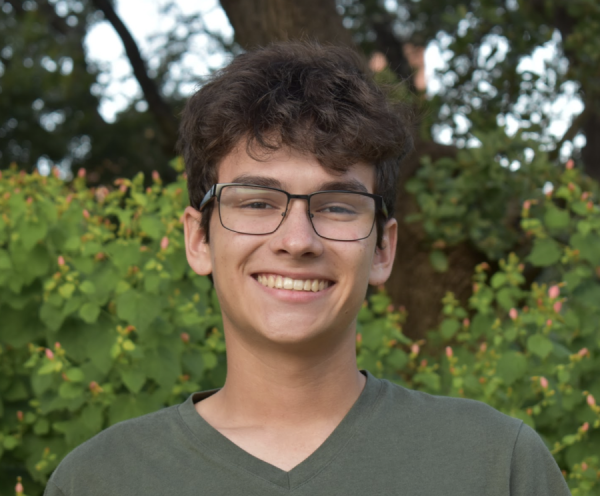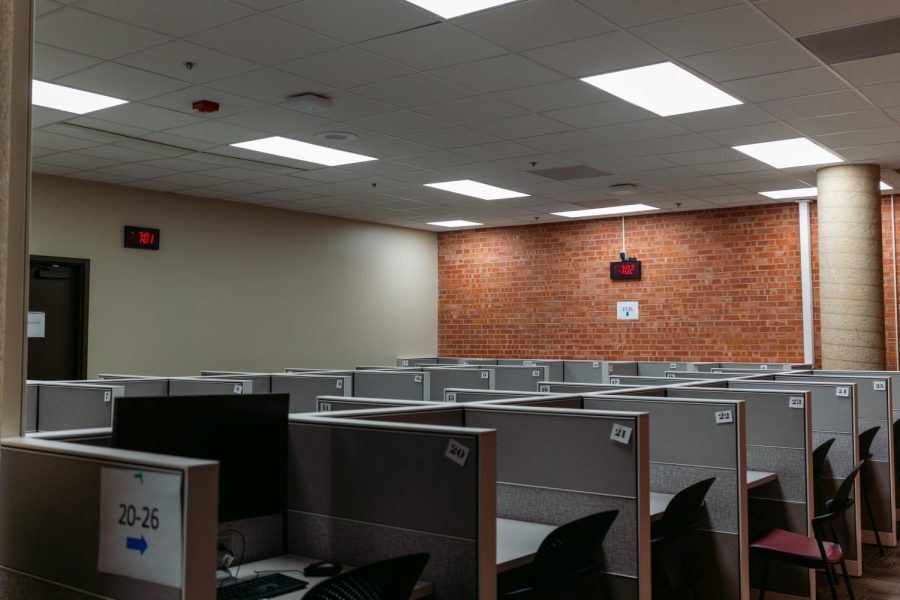How accessible is campus for disabled students?
Physical and administrative obstacles stand in the way of equitable education
The Accommodated Testing Center in Coates Library is one of the central focuses of Student Accessibility Services.
Ani Siva, sophomore Student Government Association (SGA) senator, met with Laura Ramsey, the newly appointed director for student accessibility services (SAS) on Nov. 11, to discuss a potential collaboration between SAS and SGA to support initiatives for improving accessibility on campus.
During this initial meeting, Siva and Ramsey identified eight issues surrounding accessibility on campus, and are now working on prioritizing these issues and constructing timelines to address them. Two topics they discussed were the expansion of Tiger Tracks to help improve transit on campus for students with mobility limitations and creation of a system to help students identify and report inoperable automatic doors on campus so that they can be repaired. Because Ramsey’s purview is limited to classroom accommodations, these solutions will require collaboration with different departments, like the Trinity University police department (TUPD) and facilities services.
John Scherding, university architect and director of sustainability, oversees campus infrastructure and the campus Master Plan. According to Scherding, Trinity uses two guidelines to provide barrier-free mobility: the Americans with Disabilities Act (ADA) and the International Building Code. In an email, Scherding assessed physical accessibility on campus.
“In my opinion campus accessibility is generally good but there is always room for improvement. I am relatively new to Trinity and not as familiar with the residence halls; I have heard there are some conditions in those buildings which should be addressed,” Scherding wrote.
As a part of the 2022 Master Plan Update, which is currently a work in progress, potential projects to increase the connection between upper and lower campuses are being evaluated by the Master Plan Committee. A project of this kind has the potential to create an accessible route between upper and lower campus, other than the Murchison elevator and the ramp on the south side of Storch Memorial. Scherding explained that no concrete decisions have been made regarding future Master Plan projects.
The Master Plan Committee, which is involved in creating the 2022 Master Plan update, includes two student members who offer the perspective of the student body. According to Scherding, he greatly values student input and feedback.
“The two students on the Master Plan Committee are extremely helpful and offer important perspectives. I realize that sounds like a political statement but it’s 100% true. We have heard general feedback about accessibility issues but I don’t recall the identification of specific problem areas,” Scherding wrote.
As a disabled student, Samantha Courtney, a senior human communication major with an education minor and special education teacher, has had to navigate the physical challenges posed by a campus built on a steep hill. The location of the campus is a factor that limits the variety of accessibility solutions; however, in Courtney’s opinion, this fact should not be used as an excuse to avoid prioritizing accessibility on campus. According to Courtney, creating an environment that promotes barrier-free mobility requires critical thinking and proper maintenance of the infrastructure already in place.
“[W]hat you have needs to work and be checked. Do all of your buttons actually function? [Are] your ramps, [like] the one outside of Northrup [functional], can a wheelchair actually go over the gravel? Or should you maybe have a hard surface that isn’t going to just go everywhere, you know? Did you actually speak to someone who’s disabled to consult them about the design?
And not just like, ‘Hey, my friend has a disability. I’ll ask them what they think about this.’ No, no, like, pay them for their expertise in their area. Did you actually think ‘Maybe we should have someone who actually has lived experience in this area to consult on our design,’” Courtney said.
The issue of accessibility on campus goes beyond infrastructure. The majority of accommodations available to students, specifically in regard to physical accommodations in the classroom, are facilitated through SAS. One of the biggest issues with SAS that Courtney identified is that they are understaffed — currently, SAS is fully staffed — and have a high turnover rate, which creates a hurdle for students seeking accommodations. During Courtney’s time at Trinity, they have had a different SAS case worker every year.
“How does one person or two people serve that many? [With] that many people, it’s not possible and it’s certainly not possible to do it well. … It’s really incredibly frustrating when you create such a culture [where] … you have such a frustrating uphill battle that people leave and then the students are still here … trying to get their accommodations, trying to access their education. It’s a problem, and it’s very frustrating,” Courtney said.
Another barrier to accommodations is the website that SAS uses to organize different student forms and information, as well as the addition of new forms. According to Courtney, the implementation of the new forms this school year has created additional work for both students and professors by requiring both parties to fill out forms with confusing questions to get the student’s accommodations improved. In Courtney’s experience, it has been a difficult adjustment for professors who receive no training about the accommodations process, resulting in Courtney taking the time to actually walk a new professor through the website and the forms.
“The amount of red tape that they’ve created is ridiculous. They have gotten in the way of the entire process and complicated it and made it worse, and now they don’t have really anybody to undo it. The people who did it are not here anymore,” Courtney said.
The final obstacle students face in securing accommodations is knowing what resources are available and advocating for themselves. According to Courtney, SAS presents students with a limited range of options, and if students need accommodations beyond those, they need to be prepared to advocate for them. This means students who don’t have experience in gaining access to accommodations or are newly diagnosed are less likely to get the accommodations they need.
“It’s a meal plan. There’s a little flexibility you know, [but] there’s even less flexibility for people who don’t know what the laws are, what they’re entitled to, what they have a right to. … They present you [with] your meal plan, and then you take your meal plan or you don’t. How do you know what to advocate for if you don’t know what the options are, right? They don’t even show you the [alternative] meal plans,” Courtney said.
Courtney’s experience in advocating for themself has allowed them to access the accommodations they need; however, they explained that they avoid going to SAS for certain accommodations.
“I think in a way because I studied this kind of stuff, it’s a privilege that I know what the ADA is and I know stuff like that, right? So like, in a way it makes that easier, right, advocating for myself. I also have a lot of practice with it. And even with those things in mind, I avoided it if I can, right? Because the progression of bad to worse has gone on from freshman year to now,” Courtney said.
From Courtney’s perspective as a disabled student, the efficacy of SAS has gone downhill during their time at Trinity. Being new to both Trinity and the directorial role of SAS and at Trinity, Ramsey explained that in addressing accessibility issues on campus, she has to take into account past precedent.
“When I come in new, I have to pay attention to what has been done before. How have things been addressed? So that way we can take that and build up instead of you know, recreating the wheel so to speak. So the challenge right now is trying to learn all of this stuff from my end,” Ramsey said.
Whether the current issues surrounding physical accessibility on campus will be addressed or remain the same remains to be seen. According to Ramsey, she, John Scherding and Vanessa Beasley, president of the university — who are all new to their respective roles on campus — are all interested in creating accessibility on campus.
“I met with the architect [Scherding] and we talked about the infrastructure and the [master] plan and he’s very open to and very interested in meeting the needs of students and hearing what the needs are. Our president is very excited about creating accessibility on campus. So we’re in a good position where we have people that are eager to help make this happen. So it’s a matter of identifying what needs to be done and how do we approach doing it.” Ramsey said.
When this article was initially published, it erroneously stated that SAS only had one employee. This information was based off of the directory on the university’s website which lists Ramsey as the only employee in the department of student accessibility services.

My name is Alejandra, and I'm a senior majoring in Neuroscience. I initially joined the Trinitonian as a first-year and worked my way up from a Sports...

My name is Sam (he/him) and I'm a photographer here with the Trinitonian. I'm a senior Communications and German double major from Austin, Texas, and...







Ashley • Nov 18, 2022 at 7:49 pm
Maybe do a little fact-checking next time…more than one person works in SAS. Paraphrasing one student’s perspective is not good journalism. Get both sides. Talk to students who may benefit from SAS services. The accessibility issue at Trinity goes beyond the fault and reach of just one department–the problem is wide-spread so the solution must be cooperative.
Alejandra Gerlach • Nov 22, 2022 at 3:53 pm
Hi, Ashley!
I appreciate your concern about the thoroughness of my reporting. That being said, I can assure you I did fact-check this assertion before publication. Unfortunately, at the current moment, the only official SAS employee is Laura Ramsey — who did sit down with me to talk about accessibility on campus and whose time I was grateful for. That’s not to say that there aren’t other staff members in the TLC and the office of Academic Support that work with disabled students, like Adam Rinaldi — the part-time accommodated testing center clerk. However, according to the staff directory, there is only one employee listed under the office of SAS.
Now, if I may address your point that “The accessibility issue at Trinity goes beyond the fault and reach of just one department–the problem is wide-spread so the solution must be cooperative.” Personally, I agree. However, it’s not my place to state my own personal opinion in a news article. What I can do, is share objective facts and the perspectives of my sources. The general consensus of my sources (not unanimous) is that there are some existing hurdles currently hindering the improvement of accessibility on campus — both within the SAS office and other departments.
My goals with this article were two-fold: First, identify potential projects about improving accessibility on campus — including SAS initiatives and potential infrastructure updates. Second, highlight some of the accessibility issues that could potentially be addressed.
Thank you again for sharing your concerns. At the Trinitonian, we follow the SPJ code of ethics and I am so pleased to have had the opportunity put into action the fourth pillar of ethical journalism: Be Accountable and Transparent. (And I mean that sincerely. Talk to anyone in the news room and they’ll tell you how excited I get about journalistic ethics.). If you have any more questions regarding the content of this story or how I chose what information to prioritize, I would be happy to answer them.
Happy Thanksgiving!